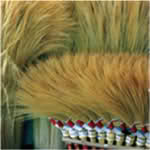 Tiger grass locally known as tambo, is a viable source of livelihood for upland communities. Tiger grass grows well in cool upland. It is usually harvested in late January and February, if dried correctly, can be stored up to a year. The upper portion of the tiger grass flower, the large dropping panicle, is used for broom making.
Tiger grass locally known as tambo, is a viable source of livelihood for upland communities. Tiger grass grows well in cool upland. It is usually harvested in late January and February, if dried correctly, can be stored up to a year. The upper portion of the tiger grass flower, the large dropping panicle, is used for broom making.
Procedure
a. Planting stock production
The common method to propagate tiger grass for better growth is by root stocks.
1. Uproot clump suckers of mature tiger grass. A one hectare plantation needs about 2,500 to 3,000 clumps, containing at least three emerging suckers.
2. Cut the upper portion leaving 10 cm of its vegetative part.
b. Site selection
* Tiger grass thrives m medium to high elevation, preferably in hillside slopes and logged-over areas.
c. Site preparation
1. Clear the area if it is to be used solely for tiger grass production or spot clear if interspersed with other agricultural crops.
2. Dig a hole 30 cm in diameter and 30 cm deep with spacing of 2×2 meters if planted alone or 4×4 meters if inter planted with other crops. Use contour planting.
d. Hauling and handling
1. Haul planting stocks to the prepared planting stocks. Do not expose to direct sunlight.
2. If possible, plant stock within the day of collection to reduce mortality.
e. Planting and Fertilizing
1. Plant at least three suckers to the prepared hole.
2. Plant during the onset of the rainy season to ensure good root and shoot development.
3. Apply fertilizer once a year, before the onset of the rainy season. Organic fertilizer can be used. However, fertilization is not a usual practice but is done in some less productive soil.
* Tip: Intercrop tiger grass with cash crops for more profit.
f. Plantation maintenance and protection
1. Replant dead ones before the rainy season ends.
2. Weed once a year or as the need arises to minimize competition on soil nutrients, water and sunlight and to minimize fire hazard.
3. Protect the area from stray animals.
4. If possible, introduce Integrated Pest Management (IPM) to minimize pest problem.
Harvesting and Hauling
The panicles usually develop from October to November and are harvested when the stalks are at least 70 cm long. Harvesting is done from December to March. The highest yield is observed on the 6th year of the plantation.
1. Cut the panicles with a sharp scythe or bolo.
2. Gather panicles and sun-dry for two to three days. Regularly turn the panicles for uniform and fast drying.
3. Slightly shake or pat dried panicles against stone or wood to remove seeds.
4. Bundle 105 panicles.
* Tip: After the last harvest, cut all the remaining vegetative parts down to 30 cm for regeneration. New tillers will develop and the cut portion can be used as fodder for animals.
* Dried panicles can be dyed and used as novelty or decorative items.
Broom Production
Materials:
* 105 panicles (maximum)
* Kawayan or wooden stick
* Tie wire
* Plastic string on split rattan
Procedure
1. Use a bundle consisting of 105 panicles (number of panicles may vary depending on the desired thickness of the broom) to make one broom.
2. Sort the panicles according to length.
3. Shear some of its first spikelets (flowers) and ensure that an average remaining length is maintained.
4. Tie these sheared spikelets to the main stem to all thickness to the broom.
5. Maintain some of the stalks to serve as handle.
6. Arrange the added spikelets (tightly bound with string) into five to six small bundles (1-1.5 cm diameter) and bind together to make one big bundle.
7. Tightly bind together the stalks using tie wire to form the handle.
8. Use wood or bamboo stick as handle. Bind together with the panicles.
9. Arrange the panicles into fan-like form with plastic string or split rattan.
10. Decorate the handle or wrap with rolled plastic or split rattan to indicate the origin of the product.
Estimated Investment Costs (based on 2008 data)
A. Annual Production Cost (in Php)
* Plantation establishment (10 man-days x P 242/man-day) P2,420.00
* Planting (10 man-days) – 2,420.00
* Re planting (1 manday) – 242.00
* Weeding/brushing (5 man-days) – 1,210.00
* Fertilization (3 man-days) – 726.00
* Harvesting and hauling (P40/1000 panicles) – 1,760.00
* Drying and cleaning (P3.00/bundle) – 1,257.00
Material cost for plantation establishment
* Planting stock (P2+20% mortality) – 6,000.00
* Fertilizer (3 bags @P150/bag) – 450.00
Broom processing
* Labor – 16,485.00
* Materials per broom – 1,676.00
* Transportation – 2,000
* Sub-total – P20,161.00
B. Net Return
* Annual Revenue (P70 x 419 pes.) – 29,330.00
* Less Annual Production cost – 20,161.00
* Sub-total – P9,169.00
C. Return on Investment
* Net Return/Annual production cost (B/A) = 0.45
Marketing
There is no problem in marketing soft brooms as long as these are of good quality. It can be sold within the community where it is produced or anywhere in the Philippines.
Brooms are sold in retail at P90 to P120/pc and wholesale at P70/pc. Price may increase depending on the decoration and thickness. Panicles can be sold to local producers in the locality. During lean months, store brooms while waiting for a better market price.
Possible investment areas are La Union, Baguio, Bataan, Nueva Vizcaya, Albay, Catanduanes, Camarines Sur, Misamis Oriental, Misamis Occidental, etc.
Registration Requirements
CLICK Here: Business permits and licenses
Supplier
* Get list of suppliers of tiger grass and other requirements with the Bureau of Domestic Trade, DTI-BDT, tel: (02) 751-3223/3227.
source: trc.dost.gov.ph
Do you like this money making business ideas? then please consider subscribing to our RSS feed and have new business ideas sent directly to your inbox. (Once you entered your e-mail address, you need to login to your e-mail account and click the link to confirm your subscription).




My place could use some cleaning. Thanks!
Excellent shareing Thanks for share i am sure its must help me in my work